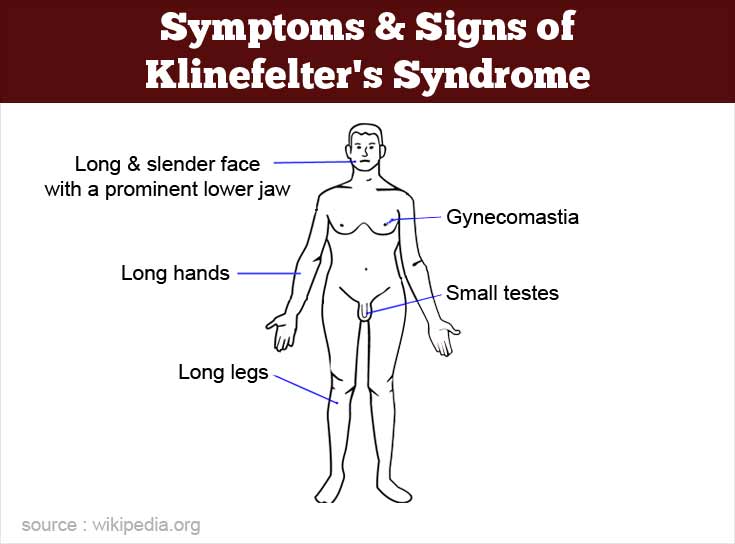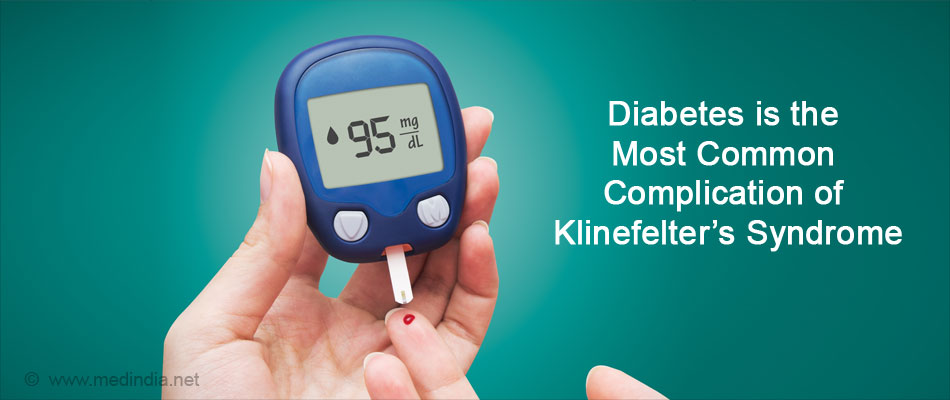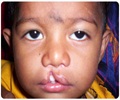- Klinefelter HF, Reifenstein EC, Albright F. Syndrome characterized by gynecomastia, aspermatogenesis without A-Leydigism, and increased excretion of follicle-stimulating hormone. J Clin Endocrinol. 1942; 2:615-27.
- Human Genetics - Problems and Approaches, Vogel Motulsky, 3rd edition
- Principles and Practice of Medical Genetics, David L. Rimoin, J. Michael Connor, Reed E. Pyeritz, Bruce R. Kort, 4th edition.
- Campbell's Urology, Walsh, Retik, Vaughan, Wein, 8th edition.
- General Urology, Emil A. Tanagho and Jack W. McAninch, 15th edition.
- Basic Human Genetics, Elaine Johansen Mange and Arthur P. Mange, Rastogi Publications.
Overview of Klinefelter's Syndrome
Normally, humans have 46 chromosomes, namely 22 pairs of autosomes and 1 pair of sex chromosomes. In females, both sex chromosomes are X chromosomes (XX), while in males, there is one X and one Y chromosome (XY).
Klinefelter's Syndrome (KS) is a sex chromosomal disorder like Turner’s syndrome. While KS individuals have an extra X chromosome making the total number of chromosomes 47 in number, a person with Turner's lacks a X chromosome and has a total of 45 chromosomes.
- Klinefelter's Syndrome (KS), was first described by Dr. Harry Klinefelter and his colleagues in 1942, while studying nine men with fertility problems and enlarged breasts. They found that the condition occurred only in males and was usually not identified until after puberty. It took another ten long years for Patricia Jacobs and J.A. Strong to demonstrate that the majority of males with KS have 47 chromosomes.
Klinefelter's Syndrome, which affects 1 in 500 to 1 in 1000 live births, is a sex chromosomal genetic disorder where the affected males have an extra X chromosome. These individuals are also referred to as 'males with XXY syndrome', or as 'XXY males'. This is not an inherited disorder.
- Normal sexual development is seen in infancy and childhood.
- Although the onset of puberty is not delayed, the post-pubertal developments are inadequate in comparison to normal males.
- KS adolescents have low levels of confidence compared to other boys of the same age.
- Although their educational achievements tend to be poor compared to their contemporaries, many KS patients show normal intelligence and function well in society. Most of them complete college and reach high positions professionally. These individuals may live their entire lives without the slightest doubt that they are in any way unusual.
Fact and Statistics
- KS affects 1 in 660 males and is a chromosomal condition that only affects males.
- It is known as the forgotten syndrome, as it is a common yet under-diagnosed genetic condition, despite being described almost 70 years ago.
- Learning difficulties might be the greatest developmental challenge that patients face as they grow older -- relative immaturity unassertiveness might still persist.
- They have a tendency to grow at a slightly quicker rate than their peers. Body hair, beard growth and testicular size are all reduced. In around 50 % of the boys growth of breast tissue occurs at puberty.
- They are usually unable to produce sperm and are infertile. They need lifelong testosterone therapy to maintain general well-being.
Klinefelter Syndrome (KS) - Variants
Genetic variation in Klinefelter individuals show three to four extra X chromosomes, extra Y-chromosomes or mosaics.
Although most patients with Klinefelter's Syndrome have only one extra X chromosome in their cells, approximately 10% of the patients have different forms of the disorder. In a few rare cases, the affected individuals have three to four extra X chromosomes (48,XXXY or 49,XXXXY) or extra Y-chromosomes. Such patients are likely to suffer from severe abnormalities, including mental retardation and social behavioral problems. A majority of these patients are confined to mental or penal institutions.
In a small proportion of the Klinefelter individuals, a few of the body cells may be normal while the others may have an additional X chromosome. These individuals are referred to as mosaics. Depending on the proportion of the cells that are normal or affected, the symptoms may either be mild, moderate or severe.
What are the Causes of Klinefelter's Syndrome?
Klinefelter’s Syndrome occurs as the result of an error during the formation of an egg or a sperm that results in a person having a XXY combination or 47 chromosomes instead of the normal 46.
Klinefelter’s Syndrome is caused by the presence of an additional X chromosome. This error usually occurs when the chromosomes are distributed during the division of the egg or the sperm. In more than half of the cases, the extra X chromosome is contributed by the father.
Very little is known about the role of the mother’s age in bringing about this condition. Women who are 35 and older have the greatest risk of having children with Klinefelter’s syndrome. Scientists are not sure what other factors increase the risk as the error that produces the extra chromosome occurs at random.
What are the Signs and Symptoms Klinefelter's Syndrome?
The onset of adolescence in Klinefelter’s Syndrome is marked by the lack of testosterone, poor growth of secondary sexual characters, gynecomastia and sterility. Sometimes there is dyslexia, delay in speech and development.
Growth and Development
- Males with Klinefelter’s Syndrome have normal appearance at birth with normal looking male genitalia
- Right from childhood the boys with KS are approximately 2- 4.5 inches taller than boys of similar age
- Most prepubertal boys with the condition have disproportionately long legs
- Their hands and feet may also be large
- A long and slender face with a prominent lower jaw is another characteristic feature observed in many individuals with KS
- Most boys enter puberty at normal age but sometimes it maybe delayed
Newborns and children with Klinefelter’s Syndrome appear completely normal. In the majority of the cases, such individuals are identified when they come to see the doctor for
- Delayed puberty
- Infertility
- Gynecomastia in adolescence or in adulthood.
The presence of small testes, absence of sperms in the ejaculate and reduced levels of the hormone testosterone is indicative of Klinefelter’s Syndrome.
Poor development of secondary sexual characteristics such as reduced facial and body hair, poor muscular development and the presence of feminine traits, such as enlarged breasts, in the adult male is suggestive of KS.

How to Diagnose Klinefelter's Syndrome?
A thorough physical examination of an individual with Klinefelter’s Syndrome is performed and confirmed by diagnostic tests such as a Karyotype or a Buccal Smear test to look for the extra X chromosome.
Diagnostic tests need to be carried out to confirm the clinical analysis.
Diagnosis of Klinefelter’s is confirmed by either of the two tests- a Buccal Smear or a Karyotype analysis.
Hormone testing
They check for abnormal hormone levels that are associated with the XXY syndrome. It is done by using a blood sample.The hormone levels that are checked are estradiol, follicle stimulating hormone, luteinizing hormone and testosterone.
Chromosome/ Karyotype analysis
It is also called Karyo type analysis. It checks for the XXY condition by looking at the number of chromosomes using special stains in a blood sample or in a buccal smear.
Semen examination
It is used to check fertility and measures the amount and quality of seminal fluid. It is also called a sperm count. It is performed by a fertility specialist.
Prenatal Diagnosis
Women who are 35 years and older or who have a family history of genetic conditions might have a chance to detect KS while looking for chromosomal abnormalities as a part of prenatal diagnosis.
Chronic Villus Sampling
It is a diagnostic test to check if all genetic conditions or chromosomes are present,
It is carried out when the woman is between 11 and 13 weeks pregnant. The procedure consists of a fine needle being passed through the stomach of the woman and into the womb to take a sample of the plasma and analyze it. The sample is known as chronic villi. It can be tested to prove if any chromosomal abnormalities are present.
Amniocentesis
It is a test carried out at a later stage when the woman is between 15 to 18 months of a pregnancy. It extracts amniotic fluid through a fine needle from the amniotic sac. The amniotic fluid acts as a security blanket around the unborn baby and it contains some cells that have been shred from the unborn baby, which can be used to examine its chromosomes.
How to Treat Klinefelter's Syndrome?
Males diagnosed with Klinefelter syndrome should be seen by a team of specialists. The team may include general practitioners, pediatricians, endocrinologists, urologists, speech therapists, genetic counselors, and psychologists.
Testosterone therapy or replacement of the male sex hormone, testosterone, is the primary treatment for Klinefelter’s Syndrome.
There is no cure for Klinefelter’s syndrome. Treatment is used to correct some aspects of the condition and provide emotional support. As KS males are unable to produce sufficient quantities of testosterone, supplementation of this hormone is required.
Testosterone Replacement Therapy
It works by increasing the testosterone levels into the normal range. It helps improve bone density and reduces breast growth. But it cannot reverse infertility or increase testicle size. Testosterone is generally administered in the form of gels, injections or tablets.

It builds a more muscular body and promotes facial hair growth. It can be considered once puberty begins. Testosterone therapy must be initiated early in adolescence. The hormone is usually given through intramuscular injections, once in every 10 - 14 days.
It is common for the patients to have mood fluctuations or altered physical abilities during the treatment period. The dosage is started at 50 mg, which may be increased after a specified period.
Medications
- Tablets - They are given to promote the development of secondary male sexual characteristics. They can cause liver problems and hence rarely used.
- Gels - There are 3 gels available called Testim, Testogel and Tostran. Extreme care must be taken to avoid contact with females and since they are administered daily they give a very even dosage.
- Sustanon Injection - It is prescribed on a monthly basis and has been used for years. The hormone levels are high following the injection and gradually diminish before the next injection.
- Nebido Injection - It is administered every three months and since the solution is thick, it has to be warmed slightly before it's injected. The dosage level is greater in Nebido injection and its effects are long-acting.
Breast Reduction Surgery
Some males with Klinefelter’s syndrome may develop excessive amount of breast tissue. Cosmetic surgery can be done to remove the extra tissue.
Speech-Language Therapy
Some but not all children with KS have language development and learning delays. They will have difficulty processing what they hear and might be slow in learning to talk, learn, read and write. A qualified Speech Language Therapist works with a patient on a one to one basis to improve communication skills.
Behavioral Therapy
Boys with Klinefelter’s syndrome should be given a comprehensive psycho-educational evaluation (IPE) to plan appropriate educational resources and classroom placement. It will assess their learning strengths and weaknesses. Behavioral therapy can also teach social skills and productive ways to handle frustration, shyness and anger. They can help identify relationship problems and develop communication skills.
Infertility Treatment for Klinefelter’s Syndrome Patients
In Vitro Fertilization (IVF)
If you have Klinefelter’s syndrome and are considering having children then you will have to visit the infertility specialist. Men with Klinefelter’s syndrome mosaicism (46, XY/47,XXY) can be fertile. If you have viable sperm in your testes then it will be extracted and used for in-vitro fertilization(IVF)
Intra-Cytoplasmic Sperm Injection (ICSI)
ICSI involves an individual sperm directly injected into an egg. The egg containing the sperm is then placed inside the womb.
General and Supportive Management
Physical Therapy
It will help patients improve their physical strength and mental coordination. A variety of exercises such as traction, stretches and massage are done during the therapy sessions. It is recommended for boys with hypotonia and delayed gross motor skills.
Parents of XXY males have also mentioned that taking part in physical activities at low key levels such as karate, swimming, tennis and golf were helpful in improving motor skills, coordination and confidence.

Occupational Therapy
It is advised for boys with motor dyspraxia, the therapist helps the child to learn skills to help him perform basic daily activities. The earlier the treatment begins the better the outcomes.
What are the Complications of Klinefelter's Syndrome?
An individual with Klinefelter’s Syndrome is more prone to developing cancer and immune system-related disorders.
- A very common complication is enlarged teeth with a thinning surface, this condition is called taurodontism which can be seen in dental x-rays.
- Due to increased cholesterol levels there may be cardiovascular diseases
- Diabetes is common in those with Klinefelter’s syndrome.

- They also have an increased risk of pulmonary embolism and deep vein thrombosis.
- They face challenges with language delay and social functioning
A person with KS has an increased susceptibility to many conditions and these include:
- Breast Cancer Risk: Klinefelter syndrome patients are at a 20-fold risk of developing breast cancer in comparison to normal men
- Osteoporosis: Untreated males also suffer an increased susceptibility to osteoporosis possibly due to reduced levels of testosterone
- Lipids: High cholesterol levels are also observed in these individuals
- Varicose veins
- Ulcers in the leg
- Respiratory diseases (Chronic Obstructive Pulmonary Disease or COPD)
There is an increased risk of developing immune system-related disorders such as rheumatoid arthritis, thyroid disease or systemic lupus erythematosis.
Klinefelter's Syndrome - Psychological Support & Counseling
Early medical intervention and a supportive social climate promotes the well-being and overall prognosis of individuals with Klinefelter’s Syndrome
Klinefelter’s Syndrome, being a genetic disorder, is not curable. It can, however, be effectively managed with timely medical intervention and social support, enabling these individuals to live a near-normal life.
Parents and teachers should take every step to help the adolescent KS individuals to develop self-esteem and self-confidence. A warm and stimulating family and school environment early in life promotes the emotional growth of these individuals. Early diagnosis, support and appropriate counseling contribute towards improving the overall prognosis.















